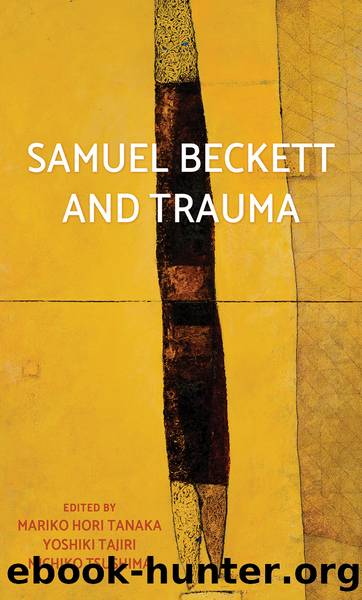Samuel Beckett and Trauma by Mariko Hori Tanaka Yoshiki Tajiri Michiko Tsushima

Author:Mariko Hori Tanaka,Yoshiki Tajiri,Michiko Tsushima
Language: eng
Format: epub
Publisher: Manchester University Press
5
Bodily object voices in Embers
Anna Sigg
In Beckettâs memory plays, such as Krappâs Last Tape, Not I, Footfalls, Rockaby, Ohio Impromptu and Embers, the characters make an almost mechanical effort to rework their traumatic pasts. Although Jonathan Boulterâs articles, such as âDoes Mourning Require a Subject?â (2004), and Russell Smithâs article (2007) on Beckettâs Endgame stress the importance of attending to the concept of trauma in Beckettâs plays, critics find it generally difficult to relate Beckettâs minimalist works to trauma theory, because, in his plays, the categories of memory, self and the past, on which the mechanism of trauma is based, have become unknowable. However, as Cathy Caruth points out, the concrete source of the primary trauma can generally rarely be located and grasped. She explains that trauma is based on a temporal delay, suggesting that âthe event is not assimilated or experienced fully at the time, but only belatedly, in its repeated possession of the one who experiences itâ (1996: 4). Although the concrete origin of the trauma is sometimes only located off-stage and thus not always accessible, it haunts the characters from a distance and speaks through their bodies. Beckettâs plays stage the condition of trauma rather than the primary traumatic event itself.
Beckett was adamant that Embers, like his other radio plays, not be performed on stage: it was meant to be broadcast as a onetime event. As a radio play, Embers effectively âblindsâ its listener and places him or her in a mental cave, a ghostly place of darkness from which the memories of traumatic loss depicted in the play emerge. Donald McWhinnie points out the âintimacy of radioâ (1959: 57), and indeed, the radio playâs intimate, ghostly atmosphere serves to create a close connection between the character and the witnessing listener of the traumatic stories. Agency is located within the lack of distance between listener and character. In a radio play the âtheatreâ, the ârepresentationâ or âperformanceâ is much more obviously inside the listenerâs head than in regular theatre. Therefore, the protagonist Henryâs commands to listen to his inner voices are most of all directed at the listener off-stage during the moment when he or she is listening to the radio play. When Henry commands: âyou neednât speak. Just listenâ (Beckett, 2006a: 209) or repeatedly utters the persistent phrase âwhite world. Not a sound. Listen to it!â (200), the âyouâ is also directed at the listener off-stage. The listener takes on an active role as he or she cannot escape into the passive realm of silence.
Embers focuses on the character Henry, who finds himself in a cycle of traumatic repetition. Boulter points out that, for Henry, âmourning [becomes] the inevitable continuation of Beingâ (2004: 336). Throughout the play, he is tortured by a roaring, internal sea-like sound, a form of âtinnitusâ â a ringing in the ears â which reminds him of his dead father and his own mortality. He describes his memories as âsome old grave [he] cannot tear [him] self away fromâ (Beckett, 2006a: 203). Henry re-enacts the stories of his past, but is unable to finish them with the use of words.
Download
This site does not store any files on its server. We only index and link to content provided by other sites. Please contact the content providers to delete copyright contents if any and email us, we'll remove relevant links or contents immediately.
| Anesthesiology | Colon & Rectal |
| General Surgery | Laparoscopic & Robotic |
| Neurosurgery | Ophthalmology |
| Oral & Maxillofacial | Orthopedics |
| Otolaryngology | Plastic |
| Thoracic & Vascular | Transplants |
| Trauma |
Periodization Training for Sports by Tudor Bompa(8173)
Why We Sleep: Unlocking the Power of Sleep and Dreams by Matthew Walker(6620)
Paper Towns by Green John(5092)
The Immortal Life of Henrietta Lacks by Rebecca Skloot(4528)
The Sports Rules Book by Human Kinetics(4299)
Dynamic Alignment Through Imagery by Eric Franklin(4119)
ACSM's Complete Guide to Fitness & Health by ACSM(3990)
Kaplan MCAT Organic Chemistry Review: Created for MCAT 2015 (Kaplan Test Prep) by Kaplan(3940)
Introduction to Kinesiology by Shirl J. Hoffman(3726)
Livewired by David Eagleman(3686)
The Death of the Heart by Elizabeth Bowen(3554)
The River of Consciousness by Oliver Sacks(3543)
Alchemy and Alchemists by C. J. S. Thompson(3452)
Bad Pharma by Ben Goldacre(3358)
Descartes' Error by Antonio Damasio(3232)
The Emperor of All Maladies: A Biography of Cancer by Siddhartha Mukherjee(3069)
The Gene: An Intimate History by Siddhartha Mukherjee(3050)
The Fate of Rome: Climate, Disease, and the End of an Empire (The Princeton History of the Ancient World) by Kyle Harper(3007)
Kaplan MCAT Behavioral Sciences Review: Created for MCAT 2015 (Kaplan Test Prep) by Kaplan(2941)
